I came into this sailing adventure knowing very little about Corsica, and even less about Sardinia. There are a few things that a Southern California upbringing lack, and an appreciation of history is one of them, especially when it involves land masses halfway around the globe. So, you’ll need to excuse me if I gloat over these substantial Mediterranean islands. Even as adults, we didn’t know what to expect when we sailed across from the French mainland. It wasn’t for lack of intel. We had so many cruising and travel guides of this area, I was afraid Sea Rose might list over and capsize. Though my appetite for history has grown leaps and bounds since grade school, travel books don’t always do a place justice, or captivate you enough in the evening after a long day on the water. You have to get right up close for an immersive, sensual experience to really get drawn in. This certainly describes our experience when we made our Corsica landfall at Galeria. And that was quickly followed by the sights, sounds and scents that are Sardinia. We just needed to rescue a few travel mates from the airport first!
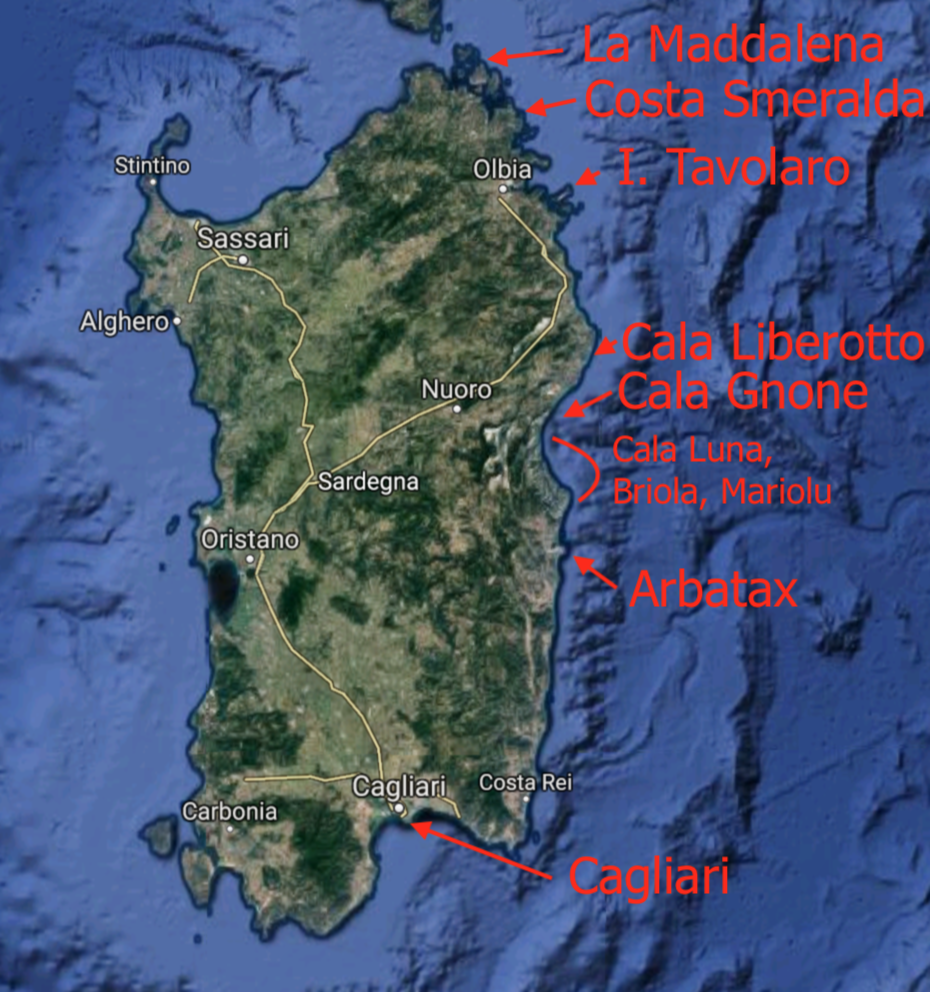
Like Emmy in Corsica, our friends Matt and Michelle had left nothing to chance when we threw out a blanket invite the prior winter. They booked sightseeing trips along the French Riviera before and after, and, given the waywardness of boat travel, had secured multiple flight reservations home from Sardinia. Here were a couple seasoned travelers well versed in the unpredictability of international travel. So it was a bit surprising when they called us in a mild panic days before their arrival regarding the cancellation of their flight from Nice. To be clear, this was not a simple, ‘Sorry sir, but we’ll put you on the next flight’ scenario. Flights in the Med are booked solid in the summer. The airlines charter all the aircraft they can muster, so when a flight drops, it is cause for concern, especially when the next available flight to Sardinia isn’t for another seven days, the sum total time you were going to be sailing onboard your friends’ boat! All four of us scrambled, scouring the internet for locations for alternative airports, airlines and meet-up locations. The rest of us were mere amateurs though; if you really want an expert in the fine art of bending travel agents to your will, it is Matt! He found a flight to Bonifacio, giving them a one day EARLIER arrival than originally planned. I began to wonder if this was all a part of their plan!
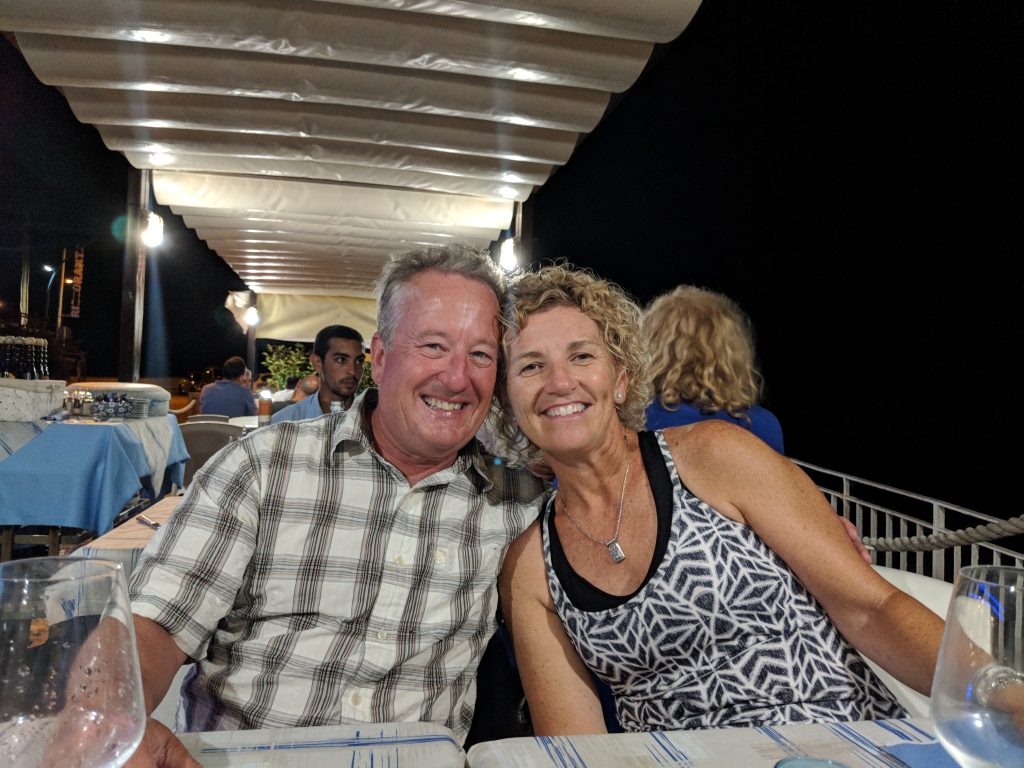
After whisking them onboard, we put Bonifacio to our stern, choosing to leave our risky mooring at Calanque de la Catena early in the morning before the harrowing winds arrived. Out in the open water, the often quoted high winds in the Bonifacio Straits were on vacation, and we skimmed gently over the water on our sailing sleigh, bound for the La Maddalena island group. In the little that I had read about these islands over the winter, and the YouTube channels that we had watched, it was clear that these islands formed the focal point of cruising in Sardinia. Our rough plan was to spend as much time as possible in the La Maddalenas, and then skirt down the coast to Cagliari so that Matt and Michelle could fly home.
Sardinia is a part of Italy, but also has its own flag. Being good mariners, we try our best to buy and fly the local flags of our host country. Although it is not mandatory, it’s good practice and it respects both maritime tradition and our new hosts.
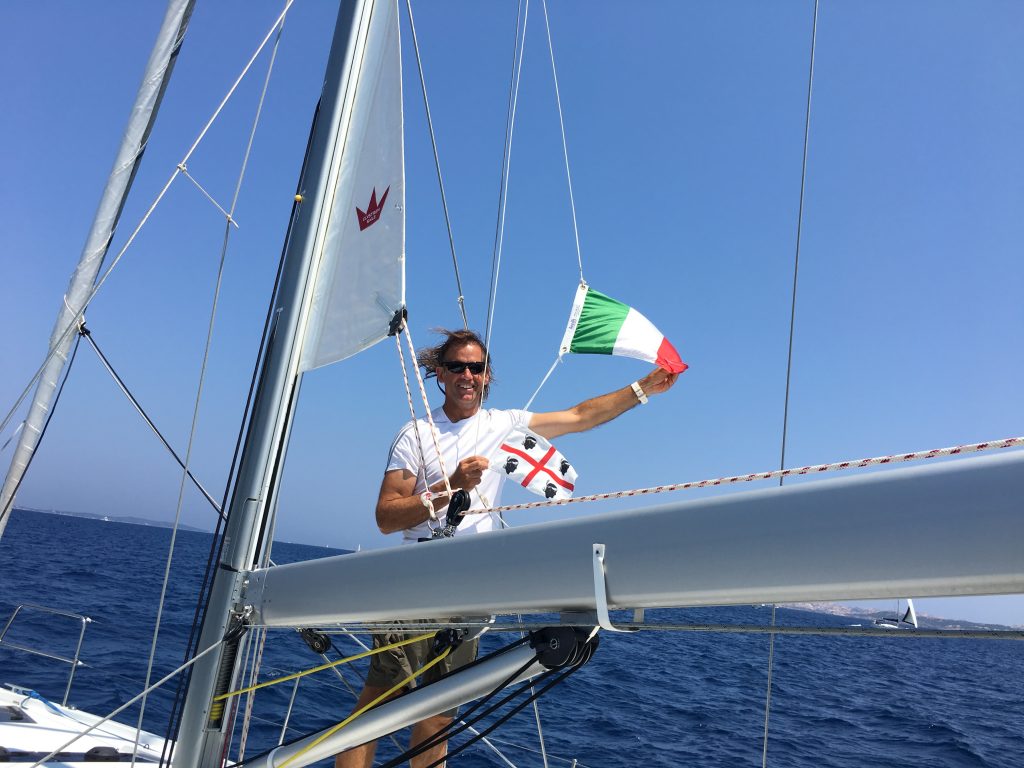
This was our first time clearing into Italy, and it was a bit different than France and Spain. Italy is a part of the EU, but for non-EU boaters like us, the cruising guide claimed that we needed to obtain a ‘Constituto’. It seemed pretty straightforward. We just needed to locate a local office of the Guardia Costiera, Italy’s Coast Guard organization, and conveniently there was one in the town of La Maddalena. Being careful not to arrive on the weekend, nor too early in the day, nor at mid-day during siesta, and after convincing the local Porto Turistico marina officer that we’d only be an hour, we tied up and ventured forth with Google maps in hand. Matt and I headed in the direction of the Guardia Costiera office, while Karen and Michelle filled up with water and washed down the boat. Frankly, I thought we had the better end of the bargain, but we soon found out, after three people pointed us in differing directions, that these coast guardsmen and women ran a pretty stealth operation!
Thirty minutes later, sweaty, and not dressed at all like the starch white sailor’s uniform of the men behind the counter, we asked in as plain English as possible how we could obtain a constituto. The confused looks in return were not the result of poor English skills. No one had apparently heard of such a thing as a constituto. We waited politely while equally polished guardia personnel checked with their senior officers, who checked with their senior officers, who then asked us ‘Who sent you?’ Huh? It’s important to be polite and keep your cool in these situations. We were visitors to their country, and must abide by their rules, and further, we were expecting them to understand our native language not us theirs. We were soon provided with visitor ID badges, and whisked back to the office of the Captaineria Di Porto. When you are the captain, you leave the details up to others, and the details of speaking English fell upon a young coast guardswomen, smartly dressed with the sharpest of white uniform creases and the tightest of hair buns, not a stitch of cloth or strand of hair out of place. Impressive! Like a trader on the floor of Wall Street, she swiftly handled the intermediary challenge in front of her, passing off the questions of her Captain to us in smooth English, and lobbing our answers back to the Captain in rocket-speed Italian. This was a well-oiled operation.
With the ink barely dry on our stamped and signed Constituto, we double-timed it back to Sea Rose to find Karen and Michelle out of breath as well. Poor little Sea Rose was side-tied to the concrete pier, an unusual convenience in the Med except for the fact that big rollers from the passing ferry traffic were rolling the docked sailboats violently against the pier. Nothing stands a chance against a sharp-edged concrete dock, especially fiberglass, and the pain of hearing the boat next to us rolling onto the concrete, while their crew explored ashore, was like finger nails on a chalkboard. It was all we could do to muscle our way off the dock with the wind and the waves wanting to destroy our investment. Barely a boat length ahead of us stood a large tour boat tied stern-to. We were off the dock, but with the wind broadside, would we turn in time without t-boning their hull? The captain wasn’t so sure, as he nervously eyed our lance-like bowsprit pointed his way like an accusatory finger. And, what is this, do I see a women at the helm of this menacing little sailboat, the captain I’m sure wondered! Once Karen deftly maneuvered us out of harms way, you never saw so many crew members (on both boats) cheering and high-fiving!
For our first night out enjoying the marine reserve of La Maddalena, we headed to Deadman’s Reef Passage. It wasn’t hard to find – it seemed like everyone was headed there. There were easily a hundred boats scattered around the undulating coves and narrow passages between rocks and reefs. The marine reserve provided mooring buoys for visiting boats, so their anchors wouldn’t damage the seafloor. But all of the buoys were taken and many more boats were anchored mercilessly in every open spot. What to do? If we anchored, would the Captaineria Di Porto come with his tight hair bunned Sirens and lure us into ship-wrecked disaster on the rocky shore? Alas, with the lateness in the day, enough boaters were leaving for us to find a snug spot close enough for a view of the shore, but safely off the rocks.
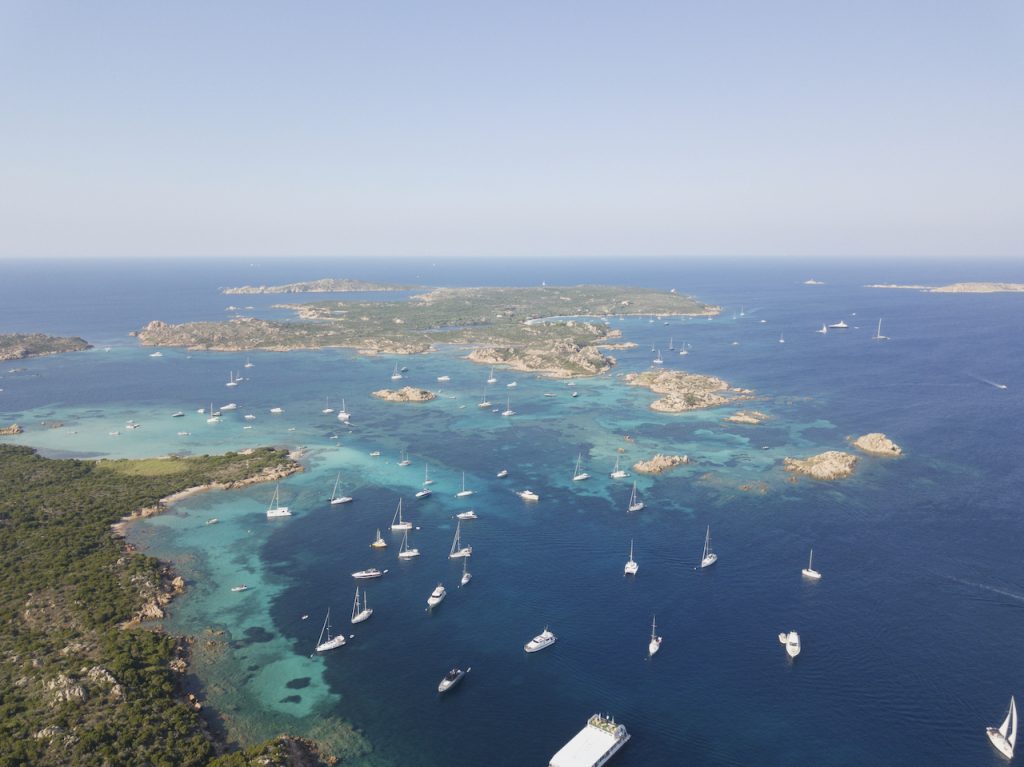
Parked next to us in the anchorage was an unusual looking craft. It had the distinct profile of an inter-island car ferry, but the curtains billowing in the breeze gave away its converted life as a floating restaurant. We had just finished up exploring the shallows by snorkel, and we had a menu planned for dinner, but the craft was too tempting to avoid. We dinghied over and were greeted by more than enough hands to take our lines. The crew seemed particularly interested in whether we wanted to stay for dinner. We didn’t wish to disappoint them with our plan of only cocktails, but they soon gave us the run of the place, letting us walk barefoot over the freshly raked sand floor in the car-deck-turned-dining-room. The owner came out from the kitchen and welcomed us, exchanging tales of his relatives in Boston, while at the same time encouraging a view from the top deck. Astroturf was the preferred floor covering here instead of sand, but the 360 degrees of views were worth whatever they were going to charge for the drinks. It looked like this beast of a vessel had been here all summer, and we wondered out loud when it last had moved. When we bid our adieu and the many hands helped us again cast off, the whole picture soon came into clearer focus. Before we were even tied back up to Sea Rose, they had hoisted their anchor and were motoring out of the harbor! It appeared that when we arrived, we had disrupted their plan to hop across to the next cove for dinner guests. Italian hospitality – I wonder how long they would have let us linger onboard!
We weren’t in as much of a hurry as our restaurant buddies, but we did raise anchor the next morning and moved on, letting Sea Rose carry us south to little Cala Cotticcio, better known locally as Tahiti Bay. We were forewarned in the cruising guide that this spot, though highly recommended for swimming, gets extremely crowded in the summer, and seeing that it was August in Europe, we were fully prepared for being skunked. It was truly chock-a-block full of boats when we pulled in, including many very expensive high speed tenders like this one.
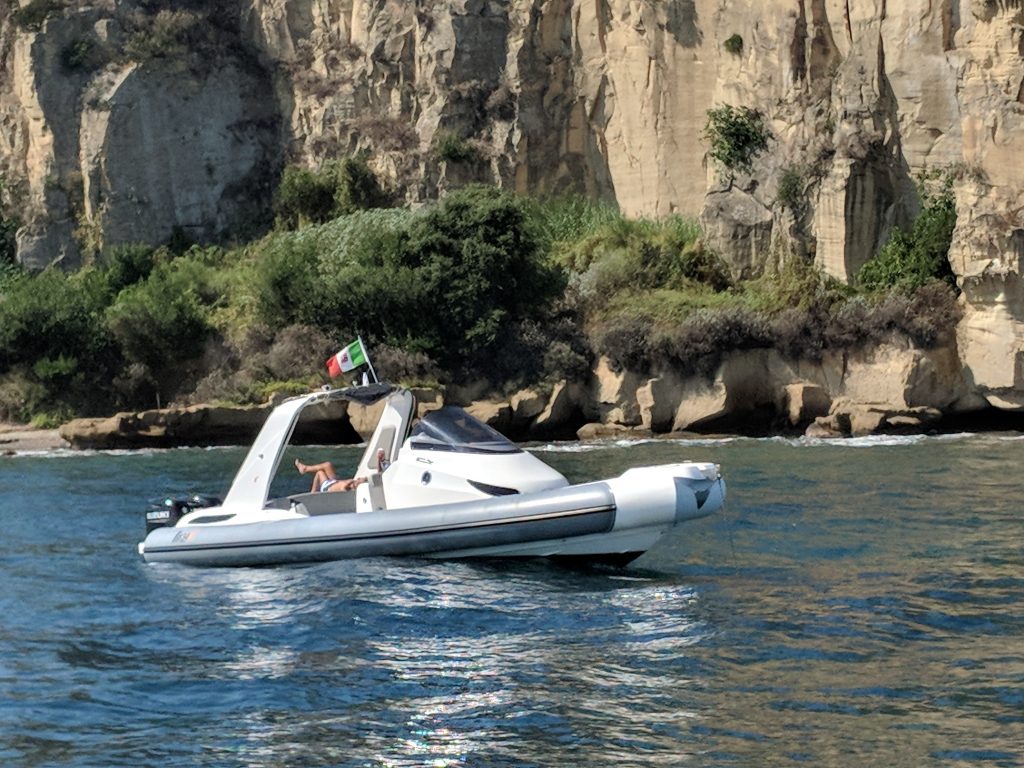
We all know Italians are high on clothing fashion, and it seems that if they also choose the hobby of power boating, they need to have the fastest, sleekest craft money can buy.
We successfully dodged these guys into the cala and found a manageable spot, albeit much deeper than we like to usually anchor. The swim into the cove was worth it though. It felt as close to a swimming pool as you could get in the Med. Aquarium clear water, bright white sandy sea floor, all at a depth just beyond what you could touch with your toes. Oh, and yes, it came with a cluster of rainbow-colored sun umbrellas on the beach!
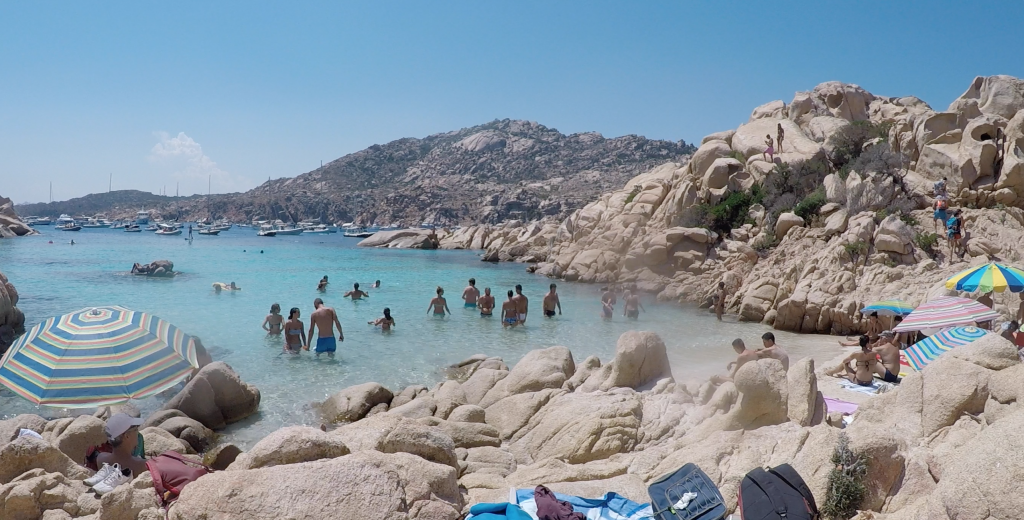
This was purely a lunch stop for us – the depth of the water and the lack of protection made it inappropriate for an overnight. We pushed on down the coast to Romazzino, a tiny indentation in the shore with a swanky beach resort surrounded on both sides by understated elegant waterfront estates, the kind that protect themselves behind enough trees and shrubs to not give away their full identity. This was our first clue that we had entered the Costa Smeralda, a region whose name also hides its identity, one of over-the-top wealth in yachting. In this on-the-water pecking order, there are boats (like Sea Rose), there are yachts, and then there are super-yachts. The Costa Smeralda is home to the largest super yachts in all of Italy, and judging from the variety of country flags, perhaps all of the Med. If you had many tens or hundreds of millions to spend on a super yacht, or the free cash to charter one for your holiday, the Costa Smeralda would likely be on your itinerary. In Rommazzino, we were joined at anchor by several motor yachts pushing 100+ feet. Before dinner, we watched a sailboat with a mast that, if this had been The Truman Show, would be scrapping the sky dome! It was Pink Gin, the largest all-carbon fiber sailboat in the world, coming in at 175 feet. Staring at the decks, I was shocked at how little the people looked onboard!
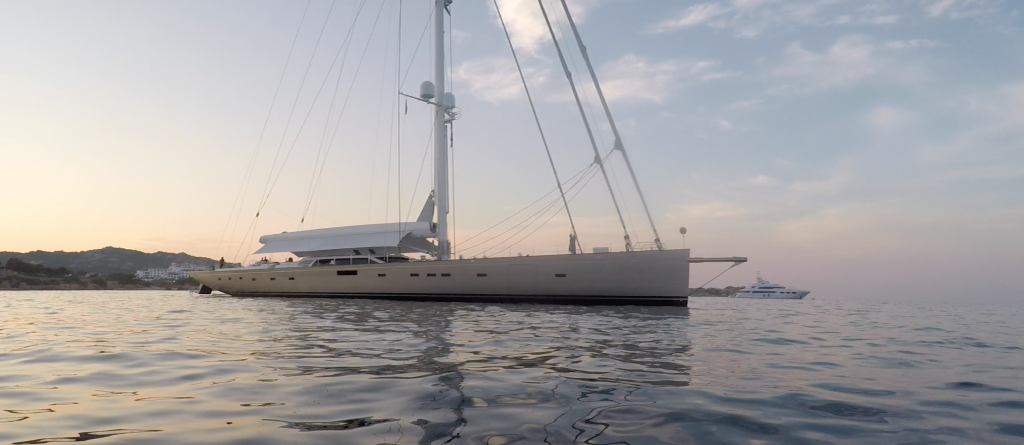
Not to be outdone, as dusk faded into night, we noticed the silhouette of a high pointed bow of a boat coming around the point, the distinct early profile of a cruise ship. The bridge appeared next, followed by the soft glow of many rows of cabin lights. Ahh, I thought, cruise ship passengers enjoying an early evening finish to their voyage. But, no, this was not a cruise ship. It was another super yacht, named ‘Ona’, owned by a Russian oligarch, coming in at 360 feet. When I googled the boat name to figure out its story, I felt bad for the owner, as there are 34 other super yachts in the world larger than this one! Poor thing. I’m sure he’s busy trying to figure out how to upgrade.
With the heat of a Mediterranean summer, and the lack of air conditioning, the water is your savior and our daily routine typically included a jump overboard once we were anchored. In Romazzino we added in a morning swim. If only every day could start and end this way.
We were low on fresh produce as well as dinghy gas, so we sailed south to Golfo Aranci, at the entrance to a bay dominated by the city of Olbia. Olbia is a major transportation hub in Sardinia, with flights, ferries, buses and trains coming and going regularly. At Golfo Aranci, we avoided the travel time up into the head of the harbor and the hustle-bustle of Olbia. Still it was quite industrial, hot, dry, and dusty. Worse, we had arrived at mid-day, and every possible grocery store option was closed for siesta. The whole siesta thing is a hard lesson for Americans to learn here. If I had a nickel for every time I tried to go shopping between noon and 2pm, I might just have enough cash to buy Ona! We decided to help time pass by ordering some yummy pizzas and liters of … you guessed it – wine! Upon departing the restaurant, we took a chance deviation down an alley, and found an open deli and butcher. I’m not sure who was happier for the opportunity – him or us!
From my reading over the winter, I really wanted to visit an unusual island named Isola Tavolara. From a long distance you can see its tall, flat profile on the horizon. At first, I thought it was a collection of storm clouds or a fog bank. But no, Tavolara rises rapidly from the water’s edge to 1800 feet. With such steep shoreline, it would hold no attraction as an overnight stop were it not for a skinny peninsula protruding from its western edge. In this high season of boating travel, there were at least 50 boats clustered in the lee of this peninsula with depths gently dropping from the shoreline making it ideal for anchoring. We couldn’t wait to explore ashore. The beauty of the geology was outstanding, yet so distinctly different from the La Maddalenas. It was quickly becoming evident this trip down the Sardinia coast was going to be an eye-popping experience.
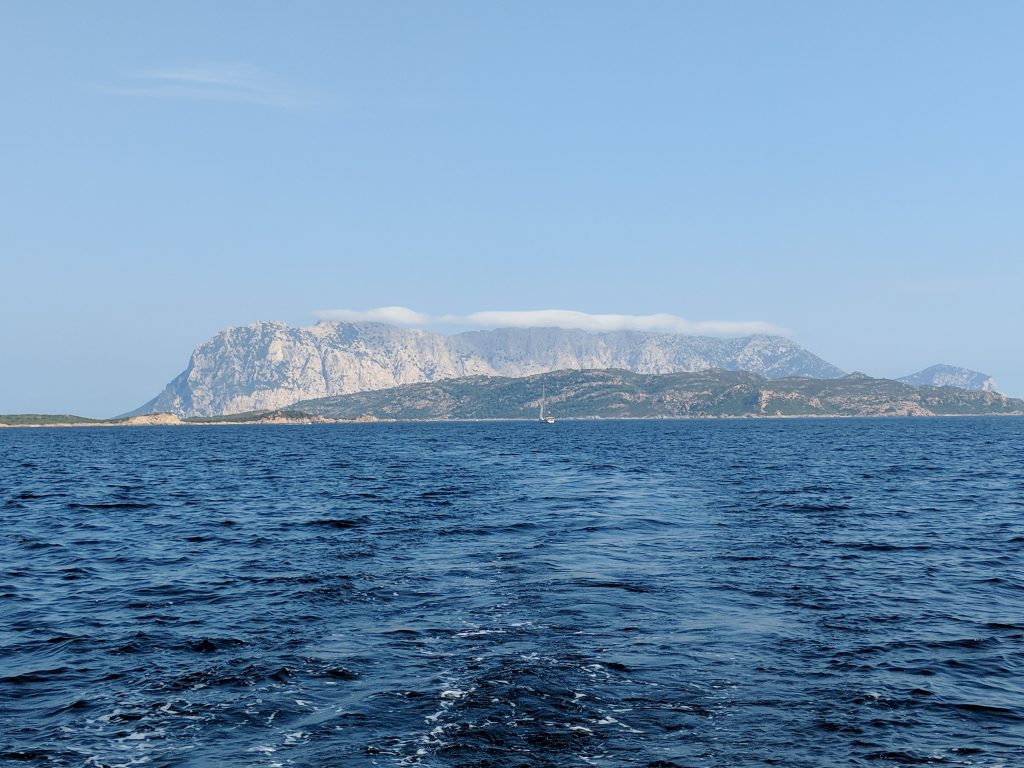
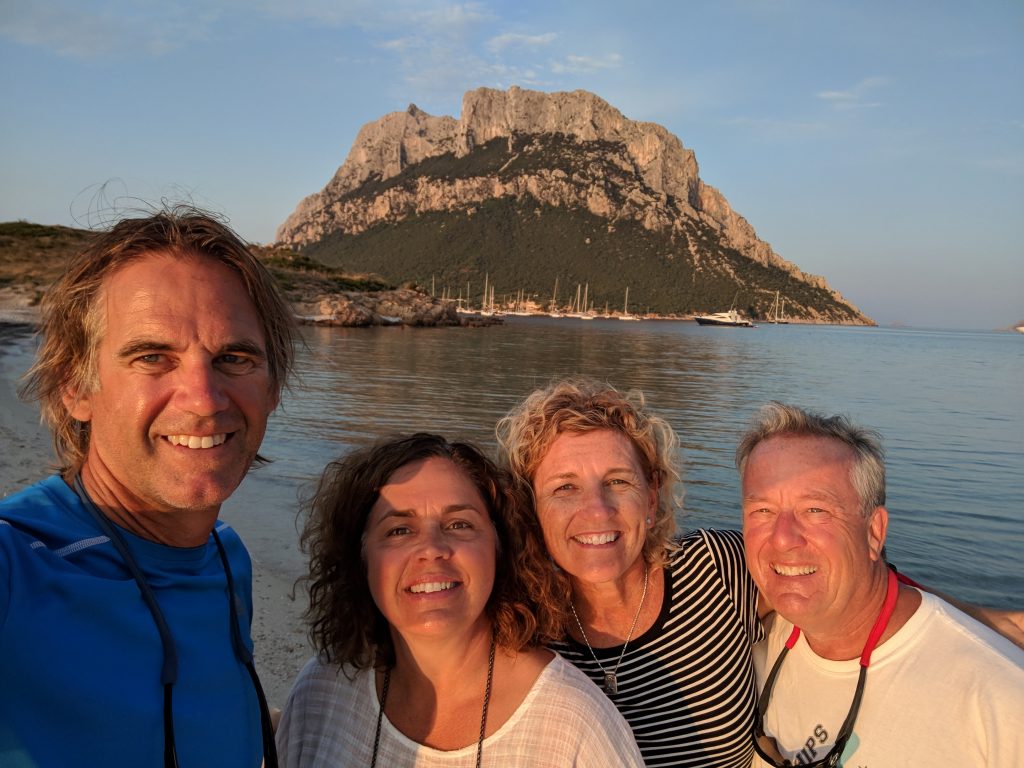
Checking Tavolara off the list, we left early to put some extra miles under the keel. Glassy calms gave way to a gentle following breeze and we spent much of the day jibing and sailing wing-and-wing. The coast south of Smeralda was not given much attention in the cruising guide. In fact, the author casually threw off this section as a coast of passage, a place with little sight-seeing potential, engaged by mariners that simply wanted to quickly get to the southern tip of Sardinia.
With these reduced expectations in our heads, we pulled into Cala Liberotto. There was a healthy breeze blowing but thankfully it was directed offshore, without enough fetch to produce any rolling waves. We dinghied ashore to a beach resort much more low-keyed than the Costa Smerlda. Gone were the super yachts and the related super estates. Here was a long, gently arcing sand beach where families with young children played at the water’s edge, and newly dating or honey-mooning couples stared dreamily into the distant horizon, likely caring as little about time beyond today as the two year old boy nearby building a sand castle.
To cut the heat of the midday Mediterranean sun, a beach umbrella is a prime necessity in these parts. And, the Italians have a very structured, color-coded method of managing umbrellas at the beach front. Each resort or beach hotel chooses their color, and as the sun comes up, the perfect grid pattern of umbrellas start opening up, forming a rainbow of colors. If you are not a guest at a resort, you might be lucky to find a narrow slice of beach unclaimed by the umbrella-toting establishments, but with real estate at a premium, don’t count on it. We ventured through a sea of green umbrellas at Cala Liberotto to check out the resort hidden in the forest of trees set back from the beach. Very little English appeared on signs, and even less could be heard being spoken, but through awkward sign language we were able to order beers and mojitos at the beach bar and check out the local beach volleyball tournament. It would have been a blast to join in on the competition, but for the first time this summer, I felt like we were barging in on the fun of local Italian vacationers, and we should best leave them to their own holiday. This was not the melting pot of Bonifacio or Palma or Marseille. We had stumbled on local vacationing Italians. While I would have liked to channel my inner Owen Wilson, crashing weddings, or beach resorts, in real life it is not quite so easy!

Back at the boat, we said goodbye to this fine day, with a sunset and au natural evening swim off the boat.
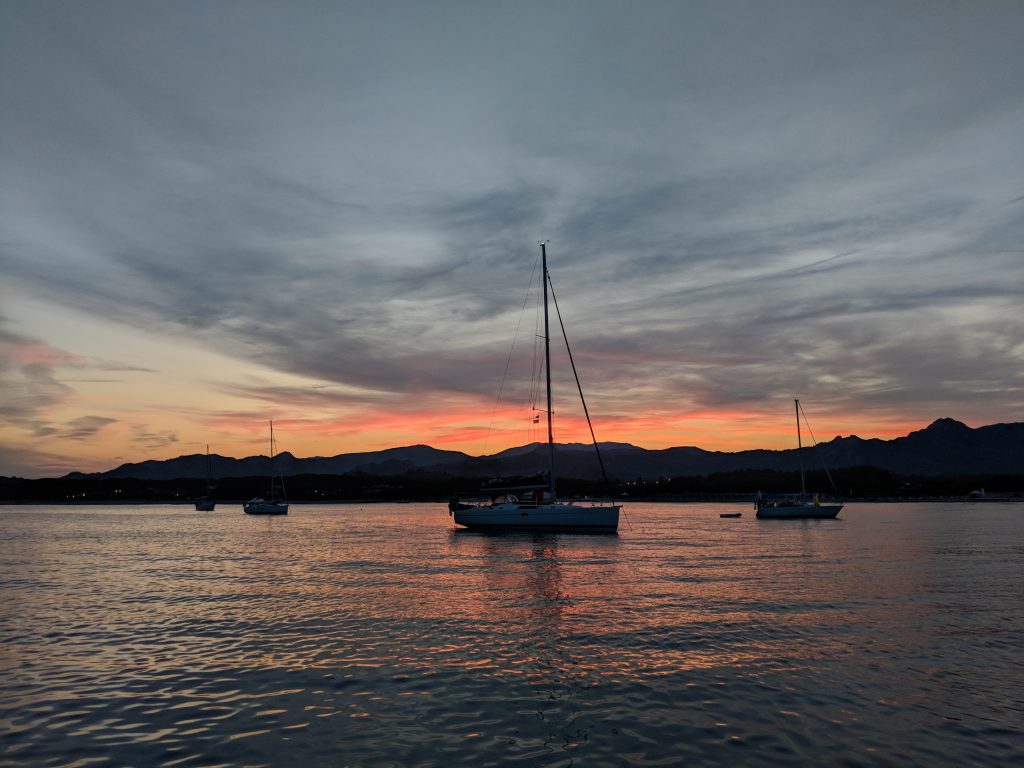
If we had followed that old mariner’s saying, the red sky at night would have heralded enjoyable weather. Yet we were awakened in the morning to the clap of thunder and approaching rain. What followed for the next four hours was cell after cell of heavy thunderstorms flying down from the interior mountains, targeting our little cove with a vengeance. Each cell, lasting 15-20 minutes and packing a powerful punch of 40-60 knots of wind, was spaced by 15-20 minutes of calm. We had been in winds this strong before, and had watched as our boat heeled over violently without any sails up while white foamy water raced across the seas surface like horizontal bottle rockets. But what made this experience different was the exhausting duration of it all. It felt like a 12 round boxing match, and each round put us further up against the ropes. The bimini and dodger shook like they would soon be lifted off the deck and taken skyward. Cockpit cushions and other flotsam from neighboring boats were cast adrift and rapidly disappeared out to sea. At one point, the wind and rain instantly switched direction 180 degrees and began drenching us in the cockpit by blowing horizontally through the opening in the stern before the boat could swing around to its new heading. This whole cacophony had arisen so quickly, we had no time to hoist the dinghy out of the water. It was rapidly filling to the gunwale with rainwater. This reality was compounded by the next cell that blew so hard we began dragging our anchor, even with the engine in full forward throttle. Matt rushed to the bow to help raise the anchor, instantly soaking his clothes all the way through. At the next calm spell, we motored far away from the rest of the boats and reset our anchor, laying out all of our 70 meters of chain – that’s nearly 230 feet of chain! By mid-day the storm cells had worn themselves out, the skies began to clear, and we changed into dry clothes as we motored down the coast to try to put this bad memory behind us. I didn’t want to worry Matt and Michelle at the time, but this was easily the worst weather we had encountered all summer.
South of Cala Liberotto, the coastline develops into a subtle bay. After reviewing the cruising guide, as we did each day to plan our destination, there was painfully little of interest noted about this region except for a marina and village at Cala Gnone, and the Grotto delle Bue Marine (grotto of the Sea-Ox). But even this grotto had a discounted review due to the apparent departure of the resident monk seals. Written by an author that first sailed these waters 35 years ago, it took effort to deflect his clear frustration with the changing times. I know I would feel the same way walking the beach of my home town, but if I had to write a visitors guide, I hope I’d be careful to not taint the joy of first time visitors from elsewhere.
Still, there was more at play here than a simple frustration with change. The cruising guide had completely skipped over a huge portion of the coastline south of Cala Gnone. It seemed like an utter oversight. Here lies the most dramatic scenery that we had seen in all of Sardinia. It was a battery-draining drone and GoPro photographer’s dream. I was beyond excited that we had pressed south, not knowing what we might find here. How fitting that we had been pounded by thunderstorms the day before, and on this day our necks ached from staring vertically upon the craggy cliffs above. Between Cala Gnone and Arbatax, where Matt and Michelle disembarked, is a string of calas that each hold a distinct color and character.
We couldn’t possibly stop at all of them, though it was tempting. We started by checking out the caves at Cala Luna which are big enough to serve as amphitheaters,
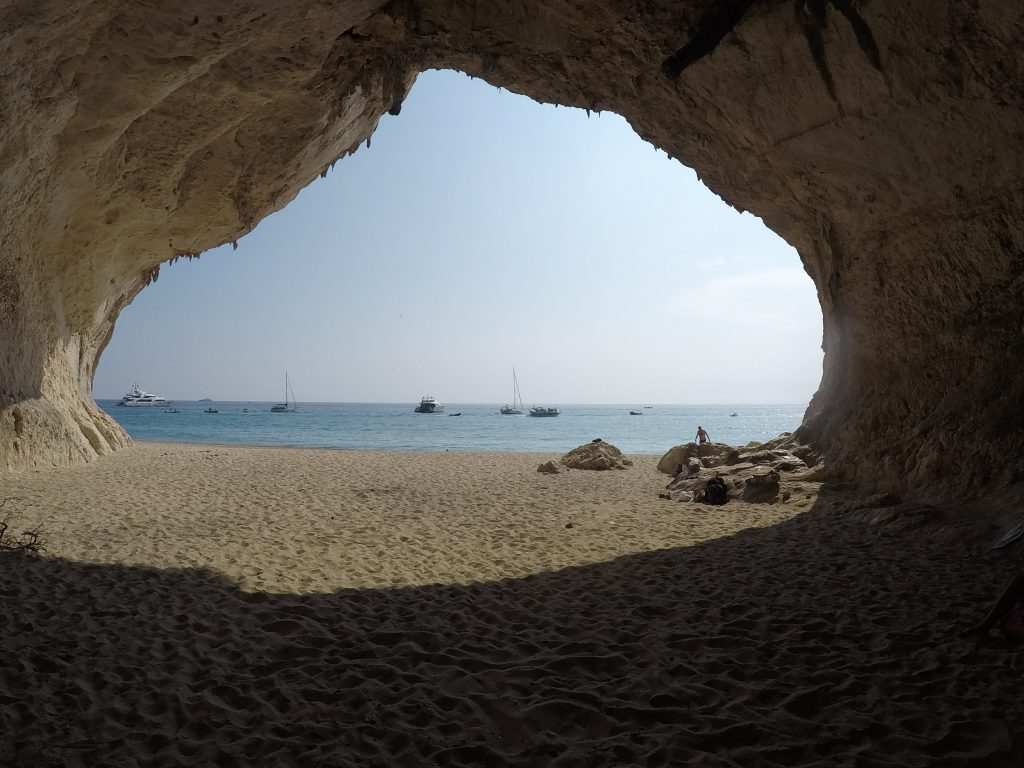
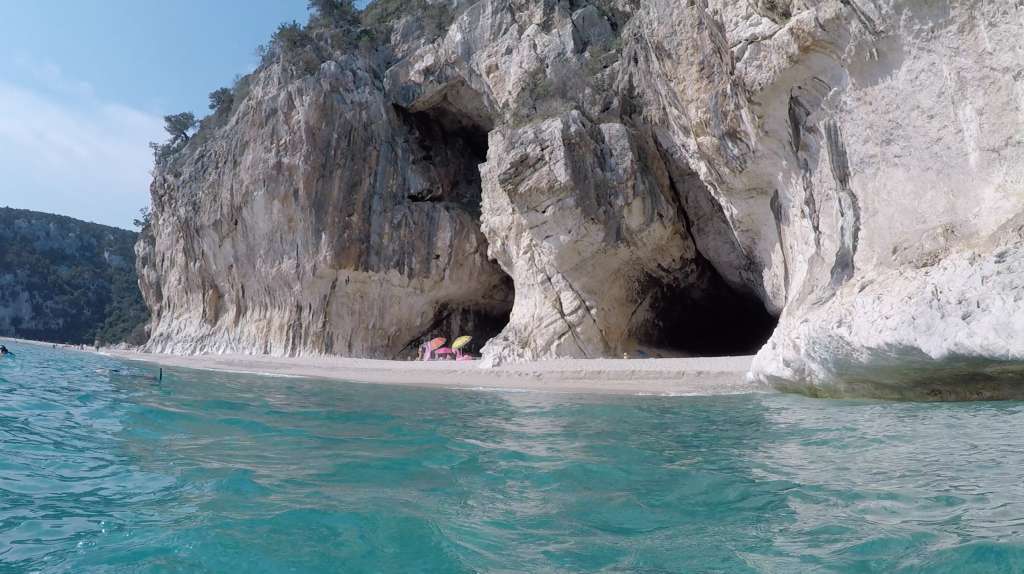
and discover a frightened octopus in the submerged jagged rocks,

before jumping off a natural rock bridge at Cala Briola,

and wrapping up the cala experience with stunning views of the tall cliffs at Cala Mariolu.

It’s refreshing, in this age of information overload, when you discover a place you didn’t know existed regardless of how many guide books you read!
We proceeded down the coast for a short day’s hop to Arbatax to take advantage of their large, protected marina complex and nearby rental car office, snatching up a sleek Audi SUV (why don’t they rent sexy cars like this in the U.S.?!). Matt and Michelle had booked flights out of Cagliari, Sardinia’s capital city at the very southern tip of the island. Karen and I were like giddy teenagers on our first road trip, as we reveled in the comfortable, quiet, air-conditioned, dry Cagliari hotel room, with an endless supply of hot water showers.
Like so many other historic Italian cities, Cagliari grew up around a network of narrow streets more appropriate for transit on foot and horseback than by car.
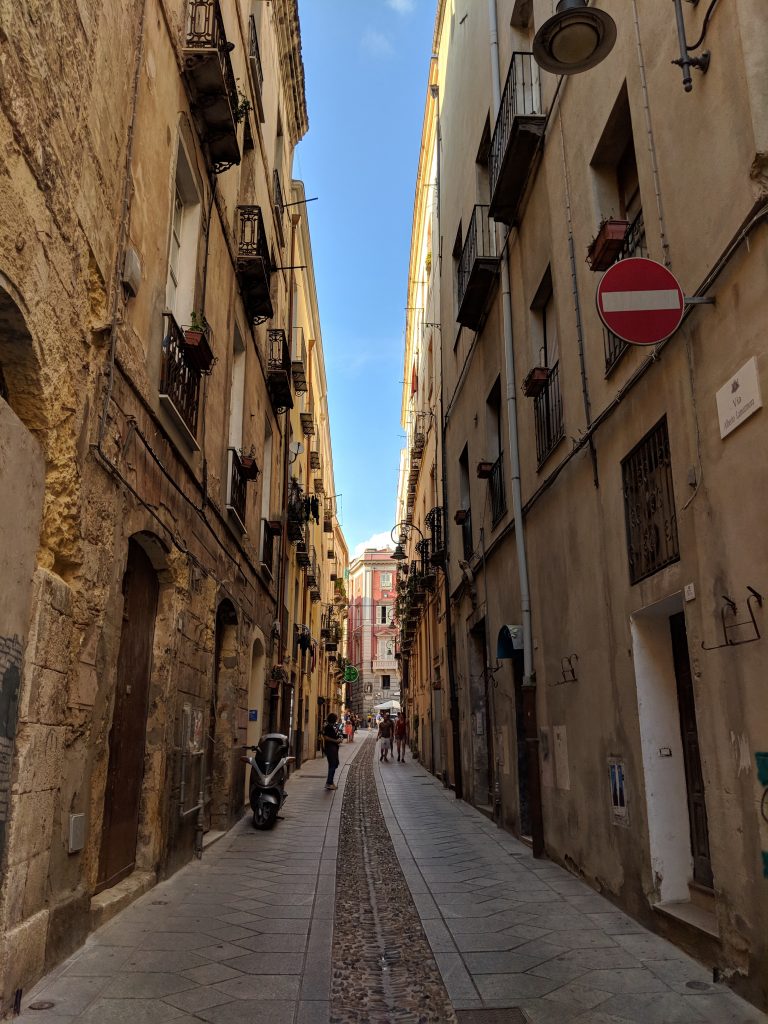
After a few fine meals that didn’t require cooking and cleanup onboard Sea Rose, we said goodbye to Matt and Michelle, looping through the interior of Sardinia before returning back to Arbatax. Sardinia has a large collection of Nuragic archaeological sites, and we had the chance to tour one at Barumini. You might see these sites as a crazy pile of rock boulders, but step back to the 17th century B.C. That’s 3700 years ago for those of you reading this late at night and temporarily deprived of math skills! The engineering that went into constructing these settlements was quite impressive.
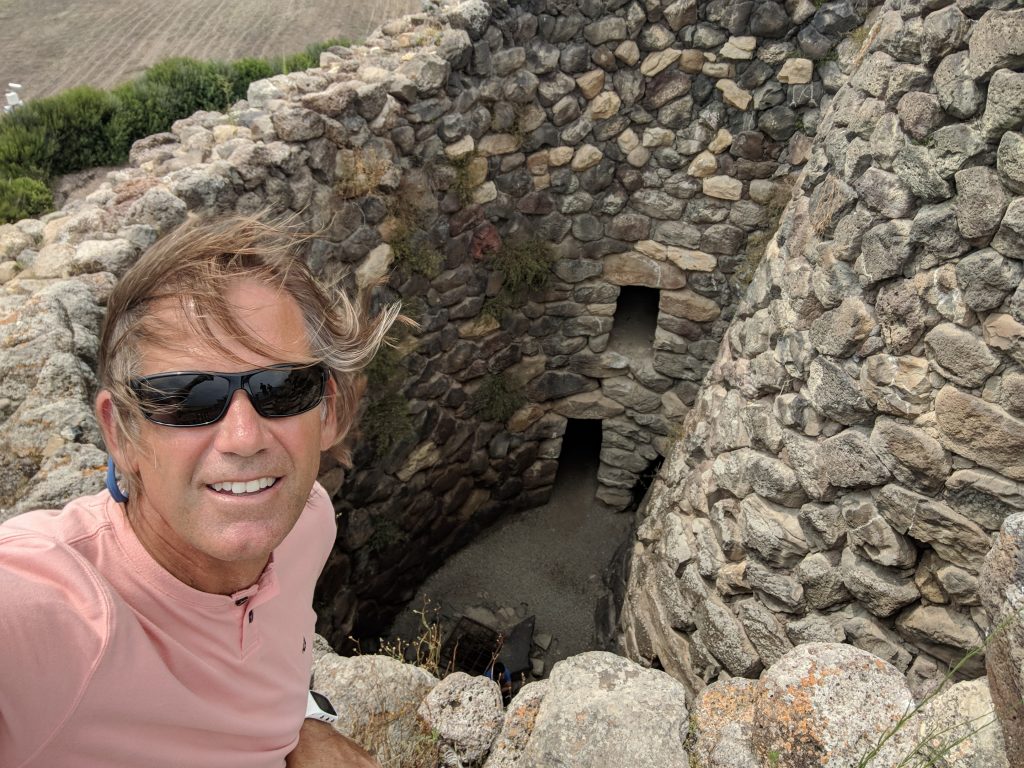
Thank you very much, Matt and Michelle, for coming onboard Sea Rose to share in our adventure and for making it more special with your kind spirit and friendship. We look forward to more adventures together in the future!
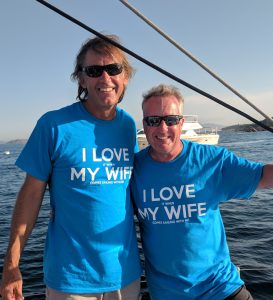
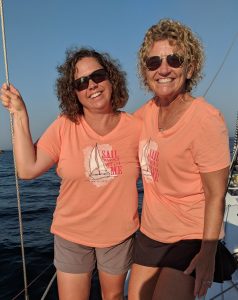
For a multimedia experience of our week in Sardinia, check out our YouTube video ‘Sailing the Coast of Sardina – SuperCALAfragilistic!’ And if you have not done so already, be sure to subscribe to our YouTube channel, LifeFourPointZero, so you won’t miss out on our new releases.
Fair winds!

